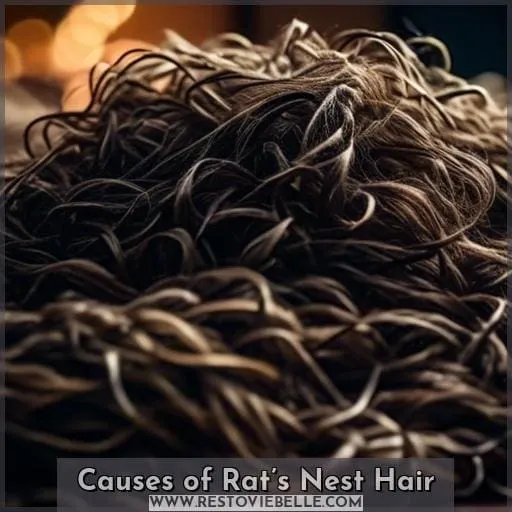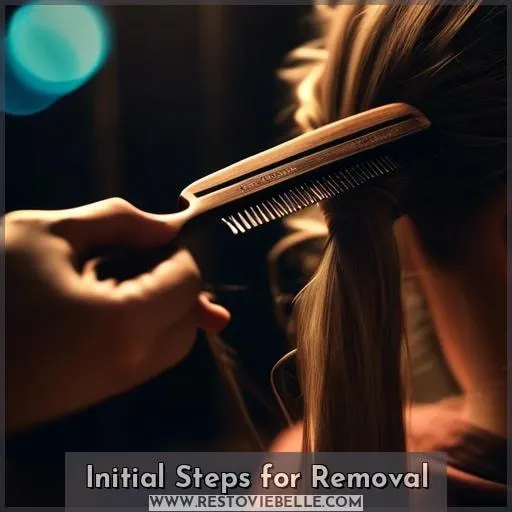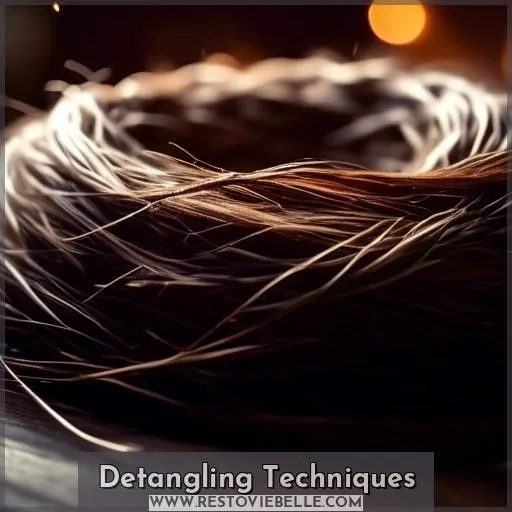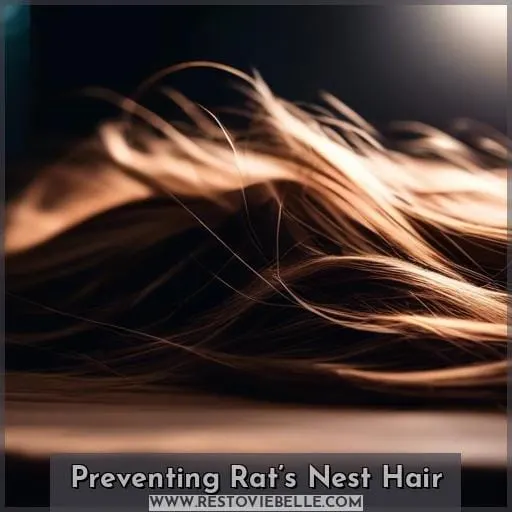This site is supported by our readers. We may earn a commission, at no cost to you, if you purchase through links.
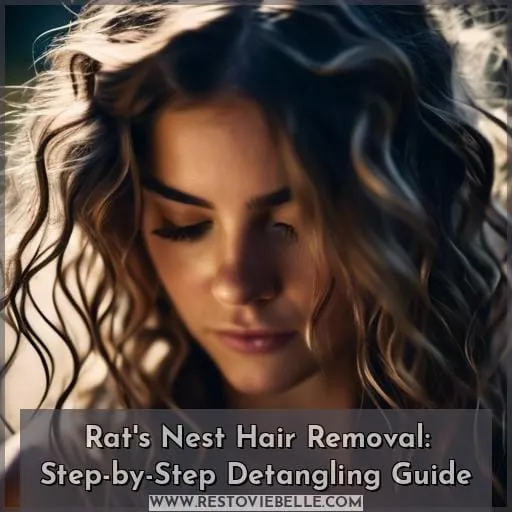 Discovering a rat’s nest in your hair can be a daunting experience, but fear not! With the right approach, you can untangle even the most stubborn knots without resorting to drastic measures.
Discovering a rat’s nest in your hair can be a daunting experience, but fear not! With the right approach, you can untangle even the most stubborn knots without resorting to drastic measures.
This guide is your roadmap through the maze of tangled hair, offering expert advice on gently removing rat’s nest hair. From understanding the causes to mastering detangling techniques, we’ll cover everything you need to know.
Embrace the journey to smoother, healthier hair with our step-by-step detangling guide, designed to empower you with knowledge and tools for maintaining beautiful, knot-free locks.
Yes, you can remove a rat’s nest from your hair by wetting the tangled area, applying a detangler or conditioner, and carefully combing through the knots starting from the ends and working your way up.
Table Of Contents
- Key Takeaways
- Rat’s Nest Hair Explained
- Causes of Rat’s Nest Hair
- Initial Steps for Removal
- Detangling Techniques
- Dos and Don’ts of Detangling
- Preventing Rat’s Nest Hair
- Frequently Asked Questions (FAQs)
- How can I safely remove a rat’s nest from my child’s hair without causing them discomfort?
- Are there any specific hair care products that are particularly effective for treating rat’s nest hair in children?
- Can dietary changes or supplements help improve hair texture and prevent rat’s nest hair?
- What are the best practices for dealing with rat’s nest hair in very long or thick hair that seems prone to tangling?
- How can I modify my hair care routine if I live in a hard water area to prevent rat’s nest hair?
- Conclusion
Key Takeaways
- Wet your hair thoroughly before attempting to detangle to prevent breakage and make the process easier.
- Use a detangler or conditioner to soften the hair and facilitate the removal of knots.
- Start detangling from the ends of your hair and gradually work your way up to the roots to minimize damage.
- Regularly condition your hair and use a silk scarf or pillowcase at night to prevent future occurrences of rat’s nest hair.
Rat’s Nest Hair Explained
You’ve just stumbled upon the tangled web of rat’s nest hair, and it’s as if your strands have thrown a wild party on your head without inviting you. Rat’s nest hair is that chaotic jumble of knots and tangles that can make you feel like you’re wrestling with a wild beast rather than simply brushing your hair.
It’s like your locks have a mind of their own, conspiring to create a labyrinth so intricate that even the most skilled hair adventurers need a map to navigate.
This tangled turmoil isn’t just a cosmetic nuisance; it’s a cry for help from your hair, signaling dryness and a plea for better hair health. The appearance of a rat’s nest can be a real downer, especially when you’re aiming for that sleek, smooth look.
But don’t fret, it’s not the end of the world for your hair. With the right damage prevention strategies and a trusty detangler by your side, you can turn that chaotic rat’s nest into a sleek, manageable mane.
Think of detangling as a delicate art form, where patience is your best tool and a good detangler is your trusty sidekick. It’s about gently coaxing those knots apart, not going into battle with them. Remember, your hair isn’t the enemy; it’s a precious asset that, with a little love and care, can be coaxed back to its former glory.
So arm yourself with moisture, a wide-tooth comb, and a sense of humor, because sometimes you just have to laugh at the bird’s nest that’s taken up residence on your head. With a bit of elbow grease and the right approach, you’ll be waving goodbye to rat’s nest hair and hello to smooth sailing.
Causes of Rat’s Nest Hair
You know the struggle: You wake up, catch a glimpse of yourself in the mirror, and there it is—a bird could mistake your head for its new home! Rat’s nest hair is like a garden that’s gone wild; it’s what happens when your hair decides to throw a party and every strand is invited.
Let’s untangle the mystery. Poor brushing habits can leave your hair in a state of anarchy, with each strand rebelling against the comb. And if you’re a fan of chemical styling, beware! Chemical damage is like a villain in a hair horror story, turning your locks into a matted disaster.
Neglecting dryness is another culprit; it’s like ignoring thirst in a desert—your hair is parched for moisture! Without it, you’re left with split ends that fray faster than a cheap sweater. And let’s not forget the lack of moisture; it’s the root of all hair evil, leaving your strands as dry as a humorless joke.
So, grab your detangling brush and prepare for battle. Finger detangling can be your secret handshake with your hair, coaxing it back to being friends.
Initial Steps for Removal
When facing the daunting task of removing a rat’s nest from your hair, the initial steps are crucial for a successful and gentle detangling process.
Begin by thoroughly wetting your hair, ensuring that the tangled areas are completely saturated. This step is essential as it makes your hair more pliable and easier to work with.
Following this, generously apply a detangler or a moisturizing conditioner, focusing on the matted sections and the ends of your hair where tangles are most likely to occur. This preparation softens the hair and prepares it for the careful detangling process that follows, setting the stage for a smoother and less damaging experience.
Wet Your Hair
When you’re battling the dreaded rat’s nest hair, the first step in your detangling strategy is to wet your hair. This is crucial because it preps your locks for a smoother detangling process, ensuring you’re not tugging at dry strands which can lead to breakage.
Think of it as laying the groundwork for a hair care routine that’s all about maintaining that precious moisture balance.
-
Drench Your Mane: Before anything else, make sure your hair is thoroughly wet. This doesn’t just mean a quick spritz; we’re talking about a full-on soak. It’s like hydrating your hair with a tall glass of water before a marathon.
-
Hydration Tips: Apply a generous amount of moisturizing conditioner or a leave-in conditioner. This is like giving your hair a hydrating shield, making it more pliable and easier to work with.
-
Curly Hair Caution: If you have curly hair, be extra gentle. Your spirals are delicate when wet, so treat them with the TLC they deserve.
-
Wide-Tooth Comb Warrior: Arm yourself with a wide-tooth comb. This tool is your best friend when it comes to detangling without causing a civil war on your scalp.
Apply Detangler or Conditioner
After you’ve soaked your locks, it’s time to bring in the cavalry: detangler or conditioner. Think of this step as laying down a smooth path through a thorny forest. Your hair, thirsty for some TLC, will lap up these moisture mavens like a desert soaks up rain.
| Detangling Spray | Leave-In Conditioner |
|---|---|
| Lightweight champion | The hydration heavyweight |
| Quick fix for knots | Deep conditioning for days |
| Spritz, comb, go! | Apply, soak in, style |
Whether you’re a fan of the spritz-and-go method with a detangling spray or you lean towards the nurturing embrace of a leave-in conditioner, the goal is the same: to transform your rat’s nest into silk.
Add a dash of argan or coconut oil for that extra gloss, and remember, this isn’t just about untangling; it’s about hair health and maintenance. So, take your pick, apply generously, and gently work through those tangles. Your hair will thank you, emerging not just detangled but deeply nourished, ready to face the world with strength and shine.
Detangling Techniques
When facing the daunting task of removing a rat’s nest from your hair, it’s crucial to approach the situation with patience and the right tools.
Finger detangling and using a wide-tooth comb or brush are your best allies in this battle. Starting with your fingers allows you to gently tease apart the larger tangles without causing unnecessary stress and breakage to your hair.
Following up with a wide-tooth comb helps further smooth out your hair, ensuring that you work through those stubborn knots effectively. Remember, the key is to be gentle and patient throughout the process to avoid damaging your hair.
Finger Detangling
Finger detangling is like whispering sweet nothings to your hair; it’s all about gentle persuasion rather than brute force.
Start with your hair drenched in a hair mask or conditioner to give it that slip-slide effect, making the tangles more pliable. Think of your fingers as magicians, gently unraveling the mysteries of your mane.
Remember, patience is your best friend here. It’s not a race to the finish line but a journey to healthier hair.
And hey, while you’re at it, why not throw on a silk scarf at bedtime? It’s like giving your hair a hug, keeping it smooth and tangle-free. So, next time you’re facing a rat’s nest, remember: finger detangling, a bit of TLC, and maybe a trim to keep those ends in check.
Your hair will thank you, and you’ll master the art of detangling without turning it into a tug-of-war.
Wide-tooth Comb or Brush
Once you’ve unleashed the beast of a rat’s nest atop your head, it’s time to call in the cavalry: your trusty wide-tooth comb and detangling brush.
These detangling tools are like the superheroes of hair care, swooping in to save the day—and your strands. Picture this: you’re armed with your wide-tooth comb, a bottle of detangling spray at the ready.
You spritz and start at the bottom, gently working your way up like a knight in shining armor, rescuing your hair from the clutches of tangles.
The wide-set teeth of the comb glide through with the grace of a ballerina, while the detangling brush follows, smoothing out the aftermath like a skilled painter on canvas. It’s a battle, sure, but with these tools in hand, victory is a beautiful, knot-free head of hair.
Dos and Don’ts of Detangling
When tackling the challenge of detangling a rat’s nest in your hair, it’s crucial to approach the task with care and the right techniques.
You’ll want to avoid exacerbating the tangles or causing breakage. Start by applying a detangler or conditioner to provide slip, and gently work through the knots from the ends upward using a wide-tooth comb or detangling brush.
Dos
When you’re battling the dreaded rat’s nest, remember, it’s not just about yanking those tangles out.
- Start with the right tools: Grab a wide-tooth comb or a detangling brush. These are your knights in shining armor, ready to gently slay those knots without breaking a sweat—or your hair.
- Be a smooth operator: Before you dive into the fray, apply a detangling product. Think of it as a peace offering to your hair, smoothing the way for a tangle-free truce.
- Take it slow and steady: Rushing will only lead to breakage and more tangles. Work from the ends up, untangling the lower knots before you move up the hair shaft. It’s like climbing a mountain—pace yourself, and you’ll reach the summit with your flag of victory (and hair) still intact.
Don’ts
Don’t let detangling turn into a hair-raising horror show! Remember, your hair isn’t a battleground, so avoid going to war with wet locks. Wet hair is a fragile friend that can snap like a twig under too much tension. So, put down the brush when your hair is damp, and let’s talk detangling tools and techniques that won’t leave your scalp screaming for mercy.
Here’s a quick table to keep your detangling drama-free:
| Do’s | Don’ts |
|---|---|
| Use detangling sprays to ease the process | Brush from the roots down—this is a no-go! |
| Start from the bottom and work your way up | Rip through knots like you’re tearing open a package |
| Be gentle to prevent hair breakage | Neglect your scalp health by being too rough |
Keep your hair brushing gentle and your humor dry, unlike your hair. Remember, a little patience goes a long way, just like a small amount of detangling spray. And if you’re in a tangle, don’t just wing it—use the right tools and techniques to keep your hair flying high without the frizz.
Preventing Rat’s Nest Hair
To prevent the dreaded rat’s nest hair, it’s essential to incorporate a silk scarf into your bedtime routine. This ensures your hair glides smoothly while you sleep and reduces friction that can lead to tangles.
A consistent conditioning routine is also crucial. Applying deep conditioners can help maintain moisture and prevent knots.
Regular detangling, using the right tools and techniques, will keep your hair manageable and free of those pesky tangles.
Silk Scarf for Bed
To keep your locks luscious and tangle-free, consider incorporating a silk scarf into your night routine.
- Silk Fabric Magic: Swap out your cotton pillowcase for a silk or satin one to reduce hair breakage. These smooth surfaces help prevent friction that can lead to tangles and split ends.
- Protective Styles: Before hitting the hay, braid your hair or tie it up in a loose ponytail. This not only keeps your hair in place but also minimizes the risk of knots forming as you dream.
- Wrap It Up: Gently wrap your hair in a silk scarf. This extra layer of protection works wonders in keeping your hair smooth and free from the nightly chaos that can turn it into a rat’s nest.
Conditioning Routine
Continuing from the silky secret of wrapping your hair in a scarf at night, let’s dive into the conditioning routine that’ll keep your mane from turning into a rat’s nest. Think of leave-in conditioner as your hair’s knight in shining armor, warding off the tangles and dryness that lead to that dreaded bird’s nest look.
Now, don’t just slap on any conditioner and call it a day. A deep conditioning session is like a spa day for your hair. It’s not just about moisture; it’s about strength too. If you’re doing the strand stretch test and your hair’s begging for protein, listen to it! A coconut oil treatment can be a game-changer, especially if you warm it up a bit to really let it penetrate those parched locks.
And when it comes to oil and drying, remember, it’s all about balance. You want to lock in that treatment without turning your hair into an oil slick. So, whether you’re a curly Sue or a straight-haired Sally, make sure you’re giving your hair the TLC it needs to avoid waking up to a nest on your head.
Regular Detangling
To keep your locks from turning into a bird’s nest, it’s all about the right tools and a bit of TLC. First off, toss out that medieval torture device you call a comb and invest in a detangling brush that treats your hair like the crown it is.
Whether your mane is straight as a ruler or curly as a corkscrew, there’s a brush out there that won’t wage war on your tresses.
Now, let’s talk game plan. You wouldn’t go into battle without armor, so why treat your hair any different? Arm yourself with a leave-in conditioner or a detangling spray that’ll make those knots surrender faster than you can say smooth sailing.
And remember, your hair type calls the shots—what works for your friend with the pin-straight hair mightn’t be your curly hair’s cup of tea.
As for your maintenance routine, it’s like brushing your teeth—do it regularly, and you’ll avoid a world of hurt. Protective hairstyles can be your best friend; they’re not just stylish, they’re like a secret shield against tangles.
And when it comes to choosing products, think of it as picking your team—go for the ones that know how to play nice with your hair type.
So, keep up with your detangling tools, choose your products wisely, rock those protective hairstyles, and stick to your maintenance routine. Your hair will thank you, and you’ll be ready to take on the day, tangle-free and fabulous.
Frequently Asked Questions (FAQs)
How can I safely remove a rat’s nest from my child’s hair without causing them discomfort?
To gently tackle a rat’s nest, apply a detangler or conditioner to the affected area. Then carefully comb from the ends upward, avoiding yanking. Patience is key—think slow and steady wins the race.
Are there any specific hair care products that are particularly effective for treating rat’s nest hair in children?
For tackling rat’s nest hair in children, Johnson’s Baby No More Tangles Detangling Spray is a gentle, effective choice.
Additionally, Fairy Tales Tangle Tamer Shampoo offers frizz control and moisturizing benefits.
Can dietary changes or supplements help improve hair texture and prevent rat’s nest hair?
Yes, dietary changes and supplements can improve hair texture and prevent rat’s nest hair.
By ensuring you get essential nutrients like omega-3s, vitamins B6, B12, and protein.
What are the best practices for dealing with rat’s nest hair in very long or thick hair that seems prone to tangling?
Battling a rat’s nest in long or thick hair feels like untangling the world’s worst earbuds—frustrating and seemingly endless.
But fear not! Start with a hair detangler spray or apply conditioner to dry hair to soften the tangles.
Regular use of leave-in conditioners, detangling sprays, and moisturizing hair masks can prevent future tangling.
How can I modify my hair care routine if I live in a hard water area to prevent rat’s nest hair?
Living in a hard water area? Swap to a chelating shampoo to fight mineral build-up and use a moisturizing conditioner or mask weekly.
Consider a shower filter to soften water, and finish with a vinegar rinse for extra shine.
Conclusion
Navigating the journey from a daunting rat’s nest to silky, smooth locks might seem like a trek through uncharted territory, but with the right tools and techniques, it’s entirely possible.
Just as a sailor uses the stars to navigate the seas, you’ve learned to use detanglers, conditioners, and patience as your guiding lights.
By embracing these methods, you’re not only freeing your hair from knots but also nurturing it towards health and resilience.
So, as you move forward, keep these lessons close, and let them guide you to maintaining beautiful, knot-free hair.
Your journey doesn’t end here; it’s just the beginning of a lifelong voyage towards understanding and loving your hair in all its forms.

